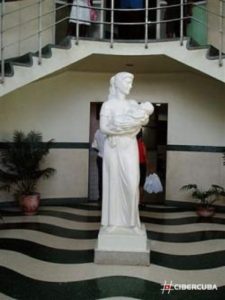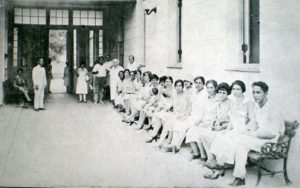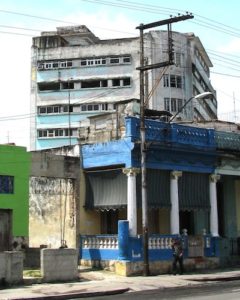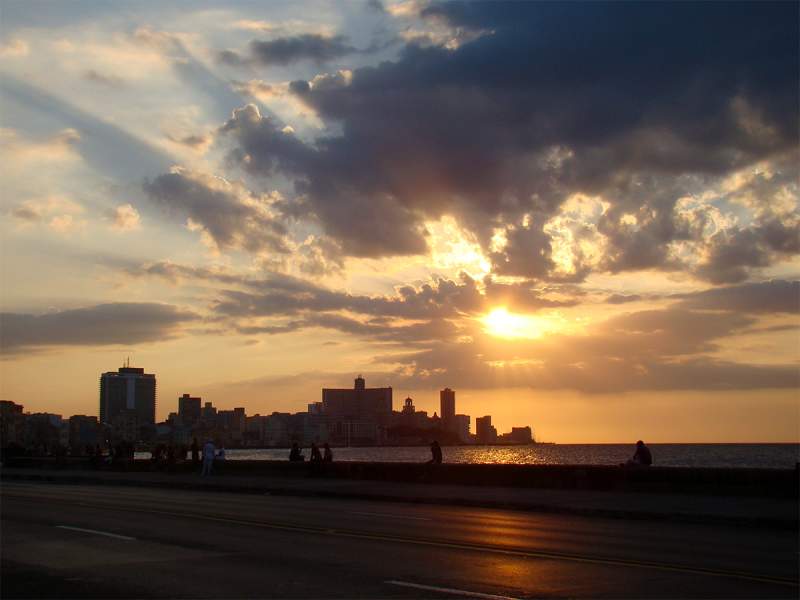Very few know how and why this health home arose and if they know they prefer not to remember it. It is a harrowing story documented in a book by the Cuban historian Julio César González Pagés. It was born as a brotherhood around prostitution to assist women who did not have access to hospitals and died of syphilis in the collection houses. That is the origin of Hijas de Galicia, the Hospital Materno Infantil Diez de Octubre, which provides services in the Luyanó neighborhood in Havana.
More than 60 000 Galleys arrived in Cuba at the end of the 19th century and in the early years of the 20th century. They were women alone or with small children in their shelter, generally illiterate and, of course, lacking resources; They ended up here as servants or prostitutes. They lived a reality that in their letters hid the distant family. Not a few of them joined and founded what would be the association Hijas de Galicia and the hospital of the same name. They were the black sheep of Spanish emigration and the Galician Center, with its power and representation, hid its existence and wanted to drown the society that came to life on June 12, 1912 under the name Solidaridad Pontevedresa and five years later, The 18 of January of 1917, happened to be called Daughters of Galicia.
At the beginning of the 90’s of the last century, González Pagés found in a forgotten office of the Gran Teatro de La Habana all documentation related to Hijas de Galicia. He wanted to access the original records of that institution and after finding them in Cuban and Galician archives he found them in the same hospital, where they were carefully kept. In those papers is the whole story.
At the beginning of the 90’s, many Galicians or their descendants, all very old, went to the Gran Teatro, former headquarters of the Galician Center. There González Pagés took advantage of the occasion and 120 of them told him their lives and those of their families in lengthy interviews. It was thus that the historian met the daughter of the pregnant galician who served as model for the sculpture that stands at the entrance of the Hospital Materno Infantil Diez de Octubre, which many patients worship as a saint.
The boycott of the Galician Center against the Daughters of Galicia ceased in 1919, without results. The institution took its course. It housed only women and children of both sexes, some 36 000 in total until 1956. On that date, it had an eight-storey building with five surgical rooms and ten inpatient rooms where, on average, they remained in hospital 206 patients / day. There were 39 doctors there. His budget, in 1957, was more than 968,000 pesos, a figure that included the expenses of the clinic and also of the spa that, for the associates, he had in Marianao.
Historia del Hospital Hijas de Galicia en la Habana.
Muy pocos saben cómo y por qué surgió esa casa de salud y si lo saben prefieren no recordarlo. Es una historia desgarradora que documentó en un libro el historiador cubano Julio César González Pagés. Nació como una hermandad en torno a la prostitución para dar asistencia a mujeres que no tenían acceso a los hospitales y morían de sífilis en las casas de recogidas. Ese es el origen de Hijas de Galicia, el Hospital Materno Infantil Diez de Octubre, que presta servicios en la barriada de Luyanó, en La Habana.
Más de 60 000 gallegas arribaron a Cuba a fines del siglo XIX y en los años iniciales del siglo XX. Eran mujeres solas o con niños pequeños a su abrigo, generalmente analfabetas y, por supuesto, carentes de recursos; terminaban aquí como sirvientas o como prostitutas. Vivían una realidad que en sus cartas ocultaban a la familia lejana. No pocas de ellas se unieron y fundaron lo que sería la asociación Hijas de Galicia y el hospital de igual nombre. Eran la oveja negra de la emigración española y el Centro Gallego, con su poder y representatividad, ocultó su existencia y quiso ahogar la sociedad que surgió a la vida el 12 de junio de 1912 con el nombre de Solidaridad Pontevedresa y que cinco años después, el 18 de enero de 1917, pasó a llamarse Hijas de Galicia.
A comienzos de la década de los 90 del siglo pasado, González Pagés encontró en una oficina olvidada del Gran Teatro de La Habana toda una documentación relacionada con Hijas de Galicia. Quiso acceder a las actas originales de esa institución y luego de buscarlas en archivos cubanos y gallegos terminó encontrándolas en el mismo hospital, donde las guardaron cuidadosamente. En esos papeles está toda la historia.
A inicios de los años 90, muchas gallegas o sus descendientes, todas ya muy mayores de edad, acudían al Gran Teatro, antigua sede del Centro Gallego. Allí González Pagés aprovechó la ocasión y 120 de ellas le contaron sus vidas y las de sus familias en demoradas entrevistas. Fue así que el historiador conoció a la hija de la gallega embarazada que sirvió de modelo para la escultura que se erige a la entrada del Hospital Materno Infantil Diez de Octubre, a la que muchas pacientes veneran como a una santa.
El boicot del Centro Gallego contra Hijas de Galicia cesó en 1919, sin resultados. La institución siguió su curso. Acogía solo a mujeres y a niños de uno y otro sexo, unos 36 000 en total hasta 1956. Disponía en esa fecha, en un edificio de ocho plantas, con cinco salones quirúrgicos y diez salas de hospitalización en las que, como promedio, permanecían internados 206 pacientes/día. Laboraban allí 39 médicos. Su presupuesto, en 1957, fue de más de 968 000 pesos, cifra que incluía los gastos de la clínica y también del balneario que, para los asociados, poseía en Marianao.
Agencies/CiroBianchiRoss/Extractos/Internet Photos/Arnoldo Varona/TheCubanHistory.como
THE CUBAN HISTORY, HOLLYWOOD.








